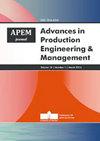求助PDF
{"title":"基于联合平方根立方卡尔曼滤波和同步定位映射的神经网络框架估计移动机器人的位置和姿态","authors":"D. Wang, K. Tan, Y. Dong, G. Yuan, X. Du","doi":"10.14743/apem2020.1.347","DOIUrl":null,"url":null,"abstract":"The real‐time performance of target tracking, detection, and positioning behaves not well for non‐Gaussian and nonlinear model with circumstance uncertainty. The weak observability of the system under large noise causes the algorithm unstable and slow to converge. A new estimation algorithm combining square‐root cubature Kalman filter (SRCKF) with simultaneous localization and mapping (SLAM) is proposed. By connecting neural network weights, network input, functional types and ideal output network, the algo‐ rithm firstly update iteratively the SRCKF‐SLAM state model and observation model, then conduct the cubature point estimate (weights) neural network framework. Thus, a point set better representing the target state and a more accurate state estimation are achieved, which can improve the filtering accu‐ racy. This paper also estimates robot and characteristic states by filtering in groups. The simulation results showed that the proposed algorithm is feasible and effective. Compared with other filtering algorithms such as SRUKF and SRCDKF, it improves the estimation accuracy. Applying the new algorithm to the position filtering estimation of mobile robot can effectively reduce the positioning error, achieve high‐precision tracking detection, and improve the accuracy of robot target detection. © 2020 CPE, University of Maribor. All rights reserved.","PeriodicalId":48763,"journal":{"name":"Advances in Production Engineering & Management","volume":"17 1","pages":"31-43"},"PeriodicalIF":2.8000,"publicationDate":"2020-03-31","publicationTypes":"Journal Article","fieldsOfStudy":null,"isOpenAccess":false,"openAccessPdf":"","citationCount":"4","resultStr":"{\"title\":\"Estimating the position and orientation of a mobile robot using neural network framework based on combined square-root cubature Kalman filter and simultaneous localization and mapping\",\"authors\":\"D. Wang, K. Tan, Y. Dong, G. Yuan, X. Du\",\"doi\":\"10.14743/apem2020.1.347\",\"DOIUrl\":null,\"url\":null,\"abstract\":\"The real‐time performance of target tracking, detection, and positioning behaves not well for non‐Gaussian and nonlinear model with circumstance uncertainty. The weak observability of the system under large noise causes the algorithm unstable and slow to converge. A new estimation algorithm combining square‐root cubature Kalman filter (SRCKF) with simultaneous localization and mapping (SLAM) is proposed. By connecting neural network weights, network input, functional types and ideal output network, the algo‐ rithm firstly update iteratively the SRCKF‐SLAM state model and observation model, then conduct the cubature point estimate (weights) neural network framework. Thus, a point set better representing the target state and a more accurate state estimation are achieved, which can improve the filtering accu‐ racy. This paper also estimates robot and characteristic states by filtering in groups. The simulation results showed that the proposed algorithm is feasible and effective. Compared with other filtering algorithms such as SRUKF and SRCDKF, it improves the estimation accuracy. Applying the new algorithm to the position filtering estimation of mobile robot can effectively reduce the positioning error, achieve high‐precision tracking detection, and improve the accuracy of robot target detection. © 2020 CPE, University of Maribor. All rights reserved.\",\"PeriodicalId\":48763,\"journal\":{\"name\":\"Advances in Production Engineering & Management\",\"volume\":\"17 1\",\"pages\":\"31-43\"},\"PeriodicalIF\":2.8000,\"publicationDate\":\"2020-03-31\",\"publicationTypes\":\"Journal Article\",\"fieldsOfStudy\":null,\"isOpenAccess\":false,\"openAccessPdf\":\"\",\"citationCount\":\"4\",\"resultStr\":null,\"platform\":\"Semanticscholar\",\"paperid\":null,\"PeriodicalName\":\"Advances in Production Engineering & Management\",\"FirstCategoryId\":\"5\",\"ListUrlMain\":\"https://doi.org/10.14743/apem2020.1.347\",\"RegionNum\":3,\"RegionCategory\":\"工程技术\",\"ArticlePicture\":[],\"TitleCN\":null,\"AbstractTextCN\":null,\"PMCID\":null,\"EPubDate\":\"\",\"PubModel\":\"\",\"JCR\":\"Q2\",\"JCRName\":\"ENGINEERING, MANUFACTURING\",\"Score\":null,\"Total\":0}","platform":"Semanticscholar","paperid":null,"PeriodicalName":"Advances in Production Engineering & Management","FirstCategoryId":"5","ListUrlMain":"https://doi.org/10.14743/apem2020.1.347","RegionNum":3,"RegionCategory":"工程技术","ArticlePicture":[],"TitleCN":null,"AbstractTextCN":null,"PMCID":null,"EPubDate":"","PubModel":"","JCR":"Q2","JCRName":"ENGINEERING, MANUFACTURING","Score":null,"Total":0}
引用次数: 4
引用
批量引用
Estimating the position and orientation of a mobile robot using neural network framework based on combined square-root cubature Kalman filter and simultaneous localization and mapping
The real‐time performance of target tracking, detection, and positioning behaves not well for non‐Gaussian and nonlinear model with circumstance uncertainty. The weak observability of the system under large noise causes the algorithm unstable and slow to converge. A new estimation algorithm combining square‐root cubature Kalman filter (SRCKF) with simultaneous localization and mapping (SLAM) is proposed. By connecting neural network weights, network input, functional types and ideal output network, the algo‐ rithm firstly update iteratively the SRCKF‐SLAM state model and observation model, then conduct the cubature point estimate (weights) neural network framework. Thus, a point set better representing the target state and a more accurate state estimation are achieved, which can improve the filtering accu‐ racy. This paper also estimates robot and characteristic states by filtering in groups. The simulation results showed that the proposed algorithm is feasible and effective. Compared with other filtering algorithms such as SRUKF and SRCDKF, it improves the estimation accuracy. Applying the new algorithm to the position filtering estimation of mobile robot can effectively reduce the positioning error, achieve high‐precision tracking detection, and improve the accuracy of robot target detection. © 2020 CPE, University of Maribor. All rights reserved.


